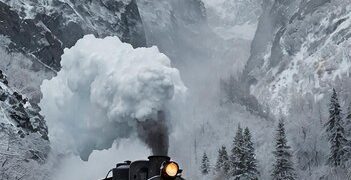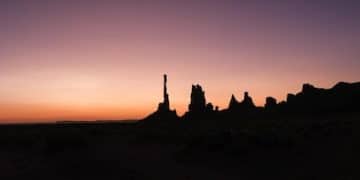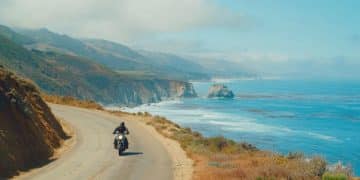The Great American Campout: Your Guide to National Forest Camping

The Great American Campout is a perfect way to embrace the outdoors, offering unique experiences and stunning views within the U.S. National Forests, ensuring memorable camping adventures.
Planning a getaway to reconnect with nature? The annual Great American Campout is the perfect opportunity to explore the vast and beautiful National Forests across the United States. With thousands of campsites to choose from, finding the ideal spot can feel like a monumental task.
National Forests: An Overview for Campers
America’s National Forests offer some of the most diverse and accessible camping destinations in the country. These vast public lands provide a range of experiences, from established campgrounds with amenities to dispersed camping in the backcountry.
Understanding the basics about National Forests helps you plan a smoother and more enjoyable camping trip. Here’s what you need to know.
What Defines a National Forest?
National Forests are federally managed lands overseen by the U.S. Forest Service. These aren’t just protected areas; they’re working forests used for timber harvesting, recreation, and conservation. This multi-use approach means that you’ll find a mix of developed facilities and untouched wilderness. Always check the forest’s website for any active logging or maintenance operations.
Why Choose a National Forest for Camping?
National Forests offer a unique blend of accessibility and wilderness. They often have fewer crowds than National Parks, allowing for a more peaceful and secluded experience. Another plus of camping in National Forests is that there is usually no fee for most campsites, except in specially designated campgrounds.
- Variety of landscapes: From mountains to deserts, National Forests feature diverse ecosystems.
- Affordability: Many camping options are free, making it budget-friendly.
- Flexibility: Whether you prefer established campgrounds or dispersed camping, options abound.
National Forests can offer a unique camping experience, with a balance you won’t find at either state parks or privately owned campgrounds. Next, how do you know what to bring to a campsite, or how to obtain a permit? Read on for more information about how to best prepare your campsite.
In summary, National Forests are ideal destinations for camping, offering affordable options and a variety of landscapes, with a balance between accessibility and wilderness.
Planning Your Great American Campout
Proper planning is essential for a successful Great American Campout in a National Forest. Before heading out, consider these key steps to ensure a safe and enjoyable experience.
From choosing the right location to packing essential gear, careful preparation makes all the difference.
Choosing the Right Campsite
The first step is to research and select a campsite that suits your needs. Consider factors like accessibility, amenities, and the type of experience you’re seeking. The US Forest Service Website is one of the best places online to find this information. You can also often find local and regional camping groups on social media.
Decide what type of camping experience you want. If you wish to experience nature with some creature comforts, then a National Forest campground may be the best choice. If you’re the type to enjoy going deeper off the beaten path, then dispersed camping may be a better option.
Permits and Reservations
While dispersed camping is generally free, some campgrounds require reservations or permits, especially during peak season. Many forests now use online reservation systems like Recreation.gov, so plan ahead to secure your spot. Many parks have a first come, first served system, and those can often be easily acquired on weekdays and the off season.
Essential Gear and Supplies
Packing the right gear is crucial for comfort and safety. Essential items include:
- Tent and sleeping bag
- Cooking equipment and food
- Water and a water filter
- First-aid kit
Don’t forget essentials such as sunscreen, insect repellent, and appropriate clothing for varying weather conditions. Consider weather forecasts and pack extra in case you get caught in a rainstorm or cold snap.
Ultimately, by taking the time to prepare, you are more likely to be able to not just visit the campsite, but enjoy being there and experiencing the wonders of nature.
Navigating National Forest Regulations
Understanding and adhering to National Forest regulations ensures not only your safety but also the preservation of these natural spaces. Familiarize yourself with the rules before you go.
These regulations are in place to protect the environment and promote responsible recreation. Always check with the particular forest service that oversees your destination to discover specific regulations, which can vary widely.

Campfire Safety
Always check fire restrictions before lighting a campfire. Use established fire rings when available, and never leave a fire unattended. Ensure the fire is completely extinguished before leaving your campsite. Be sure to be aware of any particularly dry times of year, when fires may not be allowed at all.
Leave No Trace Principles
Practice Leave No Trace principles to minimize your impact on the environment. Pack out all trash, avoid disturbing vegetation, and respect wildlife. The phrase “Take only photos, leave only footprints” is common in the outdoor recreation subculture.
Wildlife Awareness
Be aware of local wildlife, especially bears and other potentially dangerous animals. Store food properly in bear-resistant containers, and never approach or feed wildlife. It’s never a good idea to encourage wild animals to associate humans with food.
- Bear safety: Use bear canisters for food storage.
- Water sources: Filter or treat water from natural sources.
- Waste disposal: Pack out all trash and dispose of human waste properly.
By following rules and regulations, you ensure you’re being a good guest in nature. It’s important to remember that National Forests are shared spaces, and it’s the duty of those who enjoy them to uphold them for the coming generations.
In summary, staying abreast of the rules and understanding the role of federal governance in National Forests goes a long way towards protecting these natural resources for all to enjoy.
Finding Dispersed Camping Spots
For a more secluded experience, dispersed camping—also known as “boondocking” or “primitive camping”—is a great option. This involves camping outside of established campgrounds, often in more remote areas of the National Forest.
Dispersed camping offers freedom and solitude, but it requires more self-sufficiency and careful planning. Some people simply prefer the quiet natural world without other people around, and find it more relaxing and enjoyable.
Where to Find Dispersed Camping
Look for areas along forest service roads that show signs of previous use, such as existing fire rings or flattened ground. Avoid camping near water sources or in fragile areas. Be sure to avoid setting up your campsite in any area that seems to be on someone’s private property.
Rules and Guidelines for Dispersed Camping
Follow these guidelines to minimize your impact:
- Camp at least 200 feet away from water sources.
- Use existing fire rings if available, or create a small mound fire.
- Pack out all trash and waste.
Tips for a Successful Trip
Bring a map and compass or GPS device to navigate. Inform someone of your plans and expected return time. Be prepared for changing weather conditions and limited amenities.
It is worth noting that some National Forests may have restrictions on dispersed camping. Some are so popular that reservations must be made, but this is not typically the case. Be sure to do your research and follow forest regulations regarding any restrictions before deciding to embark on your adventure.
Essentially, dispersed camping offers an immersive nature experience, but it demands thorough preparation and adherence to environmental guidelines for a sustainable journey.
Activities and Recreation in National Forests
National Forests offer a wide range of activities and recreational opportunities, making them ideal destinations for outdoor enthusiasts. From hiking to fishing, there’s something for everyone.
These forests are a natural outdoor playground. Consider some of these exciting options.
Hiking and Backpacking
Explore miles of trails ranging from easy day hikes to challenging multi-day backpacking trips. Check trail maps and conditions before heading out, and always be prepared for changes in weather. Some National Forests have long-distance trails, like the Pacific Crest Trail or the Appalachian Trails. These are truly epic adventures for the intrepid hiker.
Fishing and Water Activities
Many National Forests have rivers, lakes, and streams that are perfect for fishing, kayaking, and swimming. Check local regulations regarding fishing licenses and permitted water activities. Always practice safe swimming practices; National Parks are, of course, unguarded and unpatrolled.

Wildlife Viewing
National Forests are home to a diverse array of wildlife. Bring binoculars and a camera to observe animals like deer, elk, birds, and more in their natural habitats. Be respectful of wildlife and maintain a safe distance.
Other Activities
Beyond the more prominent activities, National Forests also offer areas for:
- Mountain Biking
- Horseback riding
- Rock climbing
- Snowshoeing and cross-country skiing
By considering the available activities for the area and your personal preferences, you can be sure to spend quality time and make great memories with friends and family!
In conclusion, National Forests present a broad spectrum of recreational opportunities, making them must-visit destinations for those seeking outdoor adventures amidst diverse landscapes.
Camp Cooking and Meal Planning
One of the joys of camping is cooking and enjoying meals in the great outdoors. With some planning and the right gear, you can create delicious and memorable camp meals.
Proper meal planning not only enhances your camping experience but also reduces waste and ensures you have enough energy for your adventures. Here are some important tips.
Essential Cooking Gear
Bring a portable stove, cookware, utensils, and a cooler to keep food fresh. Consider using a Dutch oven for cooking over the campfire. There are many camping stores that offer pre-made meal plans, or you might consider doing research online to create your own.
Meal Planning Tips
Plan meals in advance and pack ingredients in reusable containers. Choose recipes that require minimal cleanup and can be cooked with one pot. Opt for lightweight, non-perishable foods such as pasta, rice, and canned goods.
Campfire Cooking Techniques
Learn how to cook over a campfire using techniques like grilling, roasting, and baking. Be cautious of hot spots and flare-ups. Always keep water nearby for emergencies. With a little experience, it will all come naturally.
Ultimately, camp cooking is about enjoying simple meals in a beautiful setting. It does not take much to grill a tasty burger or a juicy sausage over an open campfire, but the experience and the smells of the outdoors can make it more special than ever!
To summarize, with careful planning, the right gear, and simple techniques, you can create delicious and memorable meals while camping in National Forests.
| Key Aspect | Brief Description |
|---|---|
| 🌲 National Forests | Federally managed lands offering diverse camping options. |
| 🔥 Campfire Safety | Adhere to fire restrictions and never leave fires unattended. |
| 🗺️ Dispersed Camping | Camping outside of established campgrounds, offering solitude. |
| 🎣 Recreation | Enjoy hiking, fishing, wildlife viewing, and more. |
Frequently Asked Questions
▼
The best time for camping varies by location; summer is popular in mountainous regions, while spring and fall are ideal in warmer climates. Always check local weather conditions.
▼
Permits are often required for developed campgrounds and some dispersed camping areas, especially during peak season. Check Recreation.gov or the local Forest Service website for details.
▼
Look for areas off forest service roads that show signs of previous use, such as fire rings. Avoid camping near water sources or in fragile areas, and be at least 200 feet away.
▼
Leave No Trace principles include packing out all trash, minimizing campfire impacts, respecting wildlife, and staying on durable surfaces to protect vegetation.
▼
Maintain a safe distance from wildlife, never feed animals, and store food properly in bear-resistant containers. Make noise to avoid surprising animals on trails.
Conclusion
Embarking on the Great American Campout in National Forests offers unmatched opportunities to connect with nature and create lasting memories. With careful planning, adherence to regulations, and a spirit of adventure, you can discover the perfect campsite and enjoy the unique experiences these natural treasures provide. Happy camping!






